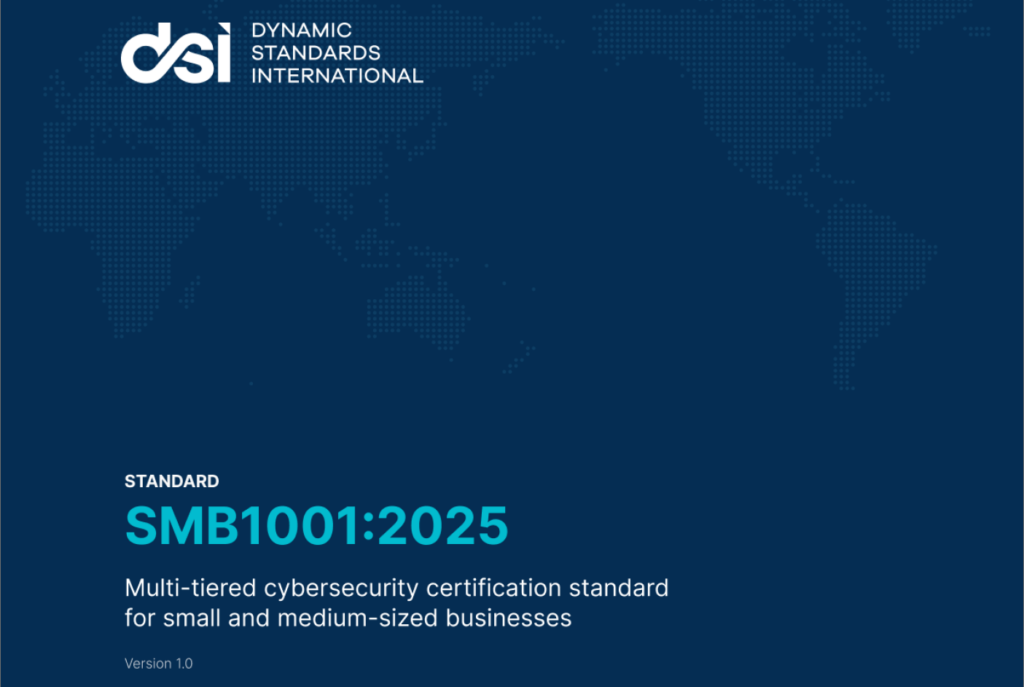
What is a Cyber Security Standard?
A cyber security standard is a set of guidelines and best practices designed to help businesses protect their systems and data from cyber threats. These standards provide a phased approach, allowing businesses to gradually improve their cyber security hygiene.
They typically focus on key areas such as risk management, data protection, compliance, incident response, and security awareness. Additionally, they promote continuous improvement of security measures to keep pace with evolving threats.
Some popular examples of cyber security standards include ISO 27001, NIST, the Essential Eight, SOC 2, and SMB1001:2025.
What is SMB1001:2025?
The SMB1001:2025 dynamic standard, developed by Dynamic Standards International (DSI), is specifically designed for small to medium businesses (SMBs). Given that SMBs make up the majority of businesses, particularly in Australia, this standard addresses their unique challenges in achieving cyber security compliance.
Unlike other cyber security standards that include extensive security controls, that are often cost prohibitive or unrealistic for smaller businesses, SMB1001:2025 stands out with its practical and scalable approach. It features a multi-tiered framework with five levels:
- Level 1 introduces the most fundamental controls.
- Level 5 represents more advanced security measures.
This tiered system allows businesses to cover essential cyber security fundamentals and gradually “level up” as their time, resources, and funding grow.
Example of Level 1 Controls:
Technology Management
- 1.1 Engage a technical support specialist for your organisation.
- 1.2 Install and configure a firewall.
- 1.3 Install anti-virus software on all organisational devices.
- 1.4 Automatically install tested and approved software updates and patches on all organisational devices.
Change Management
- 2.1 Routinely change passwords.
Backup and Recovery
- 3.1 Implement a backup and recovery strategy for important digital assets.
While these controls may seem basic, that’s the point! Many small businesses are missing these essential foundations. Each subsequent level builds upon these basics, adding more robust measures.
For example:
- Level 2 requires Multi-Factor Authentication (MFA) on all email accounts.
- Level 3 extends this by requiring MFA for all business applications and social media accounts.
This progressive structure ensures that SMBs can incrementally strengthen their cyber security posture without being overwhelmed by complex or costly requirements.
I Have Implemented These Controls in My Business, Now What?
Once you’ve rolled out all the controls for a particular level of SMB1001:2025, it’s time to get your hard work recognised. By completing an assessment (for a small fee), you can earn a certificate that proves your business has reached that level of compliance. It’s a great way to show clients and partners that you take cyber security seriously.
How the Assessment Process Works:
- Levels 1, 2, and 3:
These levels can be self-assessed using the right tools, something your IT provider would typically handle. - Levels 4 and 5:
For these more advanced levels, you’ll need an external auditor to review and validate the implementation before awarding certification.
Why Should You Implement SMB1001:2025 in Your Business?
Implementing SMB1001:2025 is a great way to adopt proven cyber security best practices. The beauty of this standard is its flexibility, you can start with the basics and build on them as your business grows.
Strengthening your cyber security posture not only reduces the risk of cyber attacks but also helps protect your data, giving you peace of mind and keeping your clients happy.
Plus, it’s highly likely that this standard will become a requirement for certain opportunities, such as tenders, government contracts, insurance policies, and more, similar to how businesses already need to meet standards like ISO 9001 (Quality), ISO 45001 (Safety), ISO 27001 (IT), or hold Security Clearances.
Want to Learn More?
If you’re interested in learning more about SMB1001:2025 or other cyber security standards, get in touch with our team. We’ll help you find the right approach to suit your business and keep your data secure.